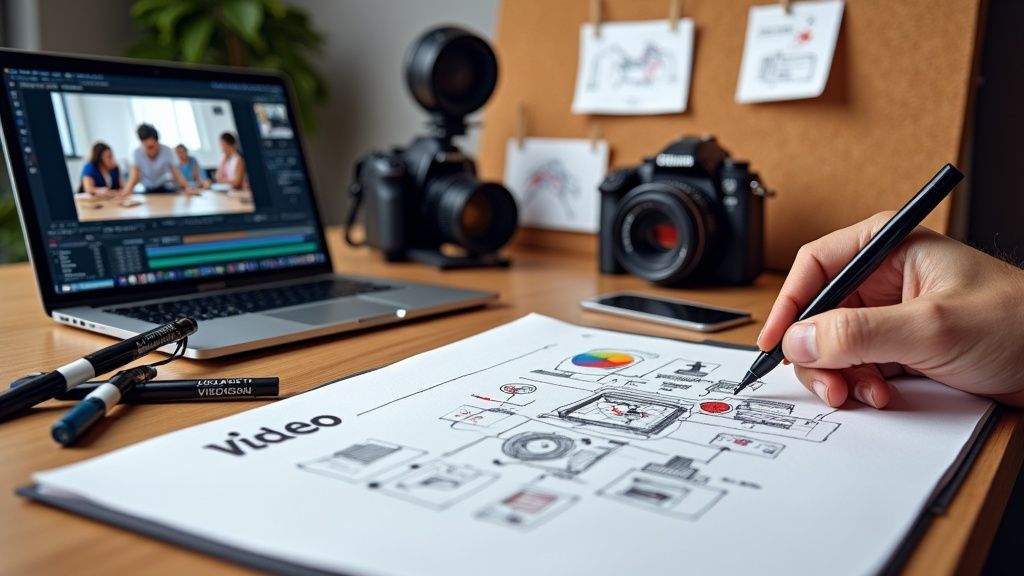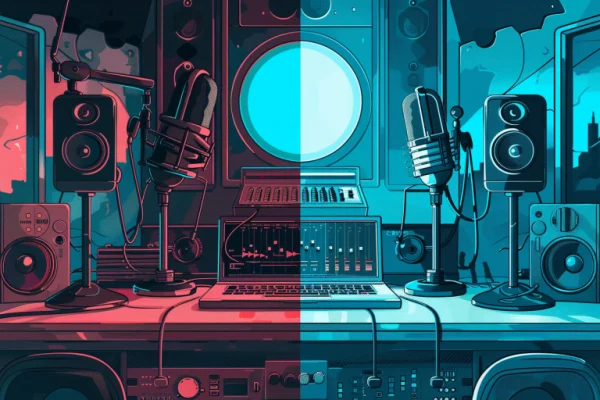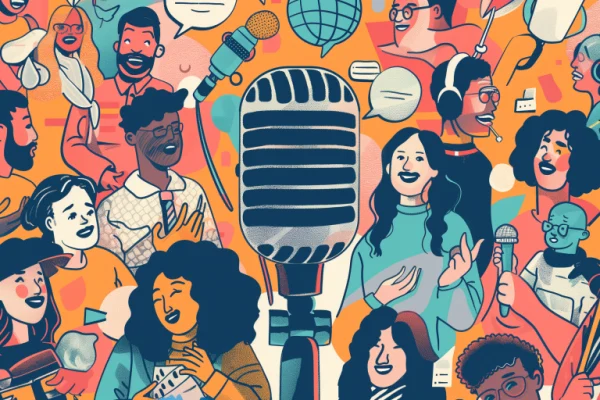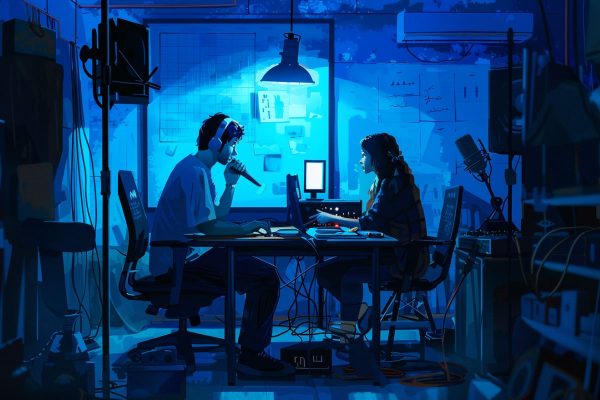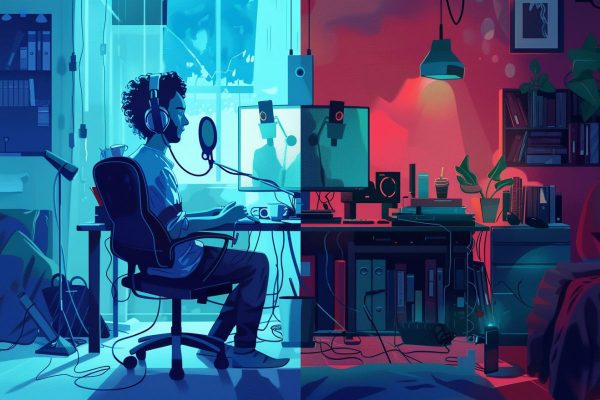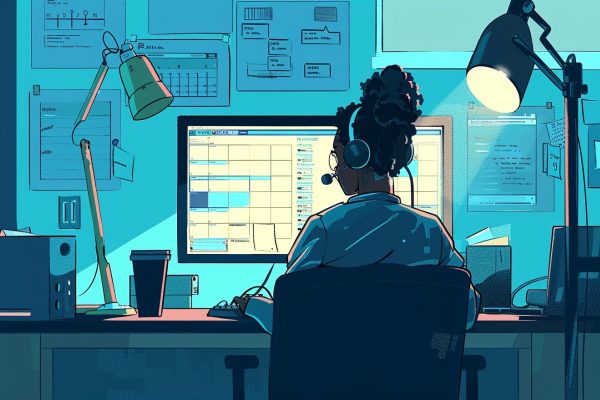A solid strategic plan is key to creating a professional video that connects with your audience. Without strategy, it's impossible to build effective content.
Key Takeaways
- Define Objective and Audience: Every video should have a clear goal and an understanding of its audience.
- Script and Storyboard: Plan the visual narrative to avoid issues before shooting.
- Flexibility for the Unexpected: Have backup plans to adapt to changes.
- Functional Equipment: Use what you need, not the most expensive gear.
- Essential Techniques: Good composition, lighting, and clear sound.
- Effective Editing: Visual storytelling and editing build a compelling story.
- Strategic Distribution: Adapt your video to each platform to maximize reach.
Mastering Strategic Planning
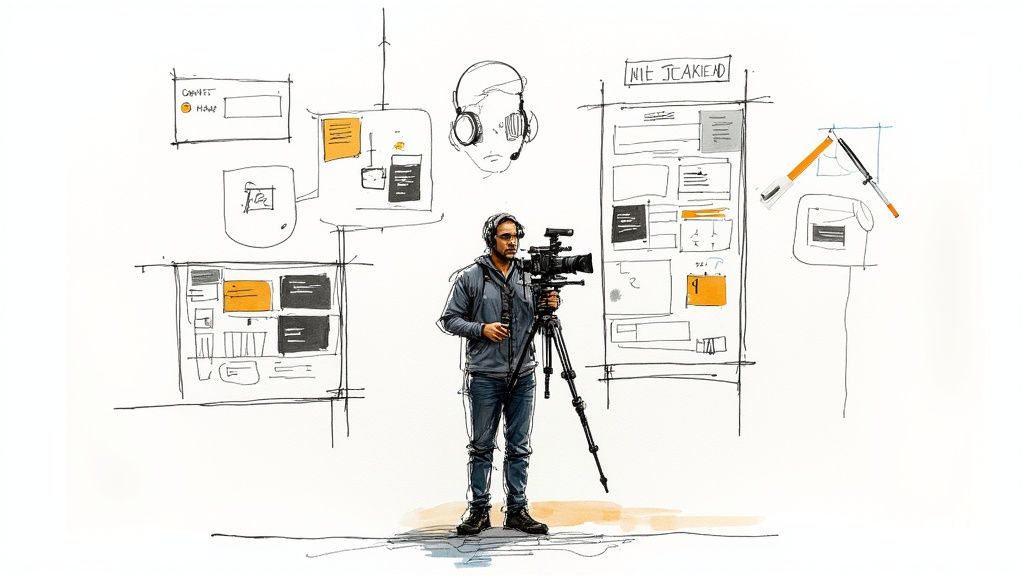
To create a quality video, planning is essential.
It's like building a house – without well-defined blueprints, the final result won’t be what you envisioned. The same applies to video: without a clear strategy, achieving coherence and connecting with your audience is difficult.
Defining the Objective and the Audience
The starting point is to be clear about what you want to achieve with your video. For instance, a tutorial has very different goals compared to a promotional video. You also need to deeply understand your audience: their interests, needs, and how they consume content. Only then can you create something valuable and relevant for them.
From Concept to Script: Structuring the Narrative
With your objective and audience defined, it's time to put your ideas into a script. This document acts as a roadmap to keep you on track throughout the creative process. A good script details the structure, key points, and the order of presentation. If you're working in a team, the script also ensures everyone shares the same vision for the project.
The Storyboard: Visualizing the Story
The next step is to create a storyboard, a series of drawings or images that show the sequence of scenes. This tool helps you visualize how the video will look before shooting begins. You can plan the shots, visual composition, and transitions. The storyboard allows you to identify potential technical or narrative problems and solve them before production starts.
Managing the Unexpected: The Key to Flexibility
No matter how much you plan, unexpected situations can arise: a host might be unavailable, bad weather could strike, or technical failures may occur. This is why flexibility and having alternative plans are crucial. This includes backup locations, extra material, and being ready to adapt the script if necessary. The ability to adapt often makes the difference between a successful project and one that stalls due to setbacks. Sometimes, last-minute changes can even lead to creative solutions that improve the final outcome.
Selecting the Equipment You Actually Need
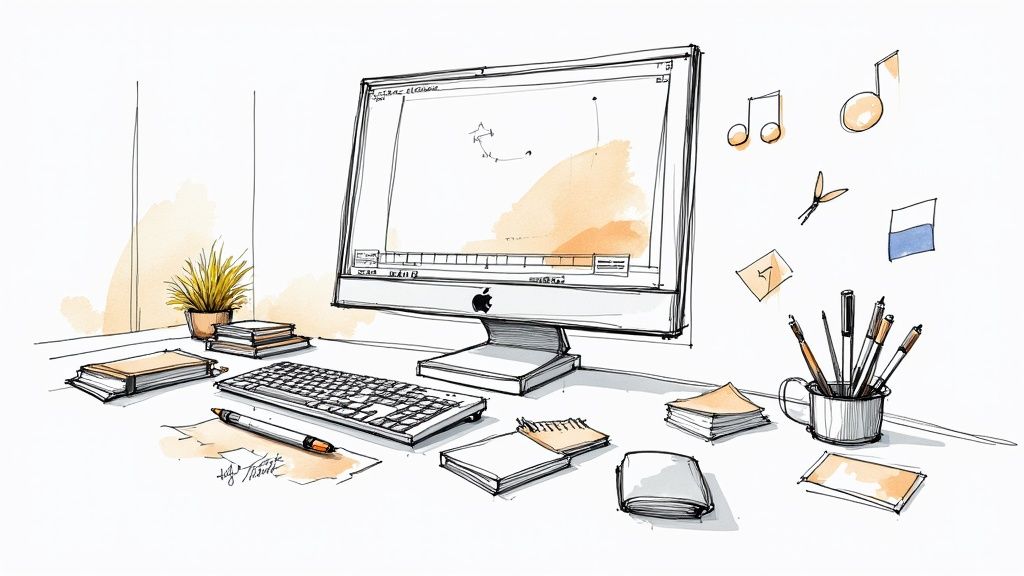
Once you’ve planned your video, it’s time to think about the necessary equipment . The key isn’t having the most expensive gear, but rather the tools that fit your goals and available resources. Often, a basic kit used well can yield better results than spending heavily on advanced technology without knowing how to use it. To create a quality video, it’s essential to focus on functionality over price.
The Camera: The Heart of Your Production
Choosing the right camera is crucial. Modern smartphones offer image quality that has made video creation more accessible. For many projects, a mid-range smartphone with a good camera may be sufficient. If you want more control over depth of field and a cinematic look, a DSLR or mirrorless camera is a solid option. Cinema cameras are ideal for larger productions but require more investment and technical knowledge.
Audio: The Importance of Clear Sound
Quality audio is as important—if not more important—than the visuals. A video with a perfect image but poor sound will quickly lose attention. Lavalier, shotgun, or condenser microphones offer different options depending on the situation. For starters, a lavalier mic is ideal for interviews and dialogue-driven videos. It’s also good to have audio editing software to remove noise and enhance recorded sound.
Lighting: Creating the Right Atmosphere
Lighting can completely change the look of your video. You don’t need professional equipment to get started. Natural light can be your best ally if you know how to use it. For example, filming near a window on a cloudy day gives you soft, even light. If you want more control, a couple of LED lights and a reflector can help you create different moods and highlight important elements in your scene.
Editing: The Final Touch
Finally, you need good editing software to assemble your video, add transitions, music, and effects. There are both free and paid options for different skill levels. Some programs offer AI features that automate tasks like color correction and image stabilization. Learning to use these tools well is crucial for putting the final touches on your video and achieving the desired result. Editing is where your story comes to life.
Recording Techniques That Make a Difference
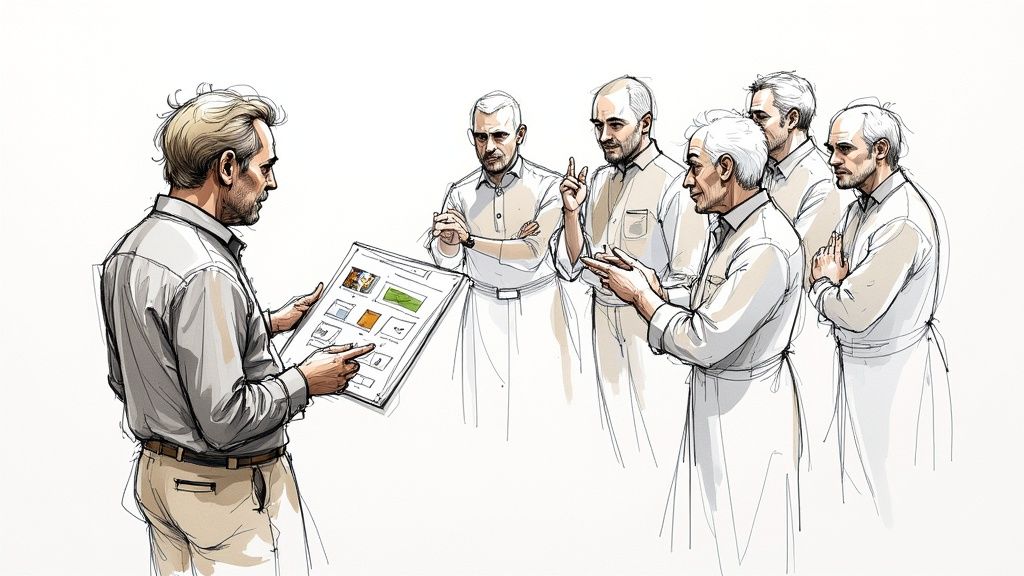
After analyzing equipment and planning, it’s time to explore the fundamental techniques that truly enhance video quality. Mastering these basics is key to creating content that connects with your audience. Every aspect—from framing to sound—plays an essential role in telling a story effectively.
Composition: The Art of Framing the Story
Framing a shot can mean the difference between an ordinary image and a memorable one. The rule of thirds is a basic but powerful tool—divide the screen into nine equal squares and place important elements at the intersections. For example, when shooting an interview, try positioning the subject in one-third of the frame instead of the center. This simple adjustment creates more visual depth and makes the image more engaging for the viewer.
Movement: Adding Dynamism and Emotion
Camera movements can bring a scene to life, but they should serve a clear purpose. A smooth pan can elegantly reveal a landscape, while a slow zoom-in can build tension or interest. The key is to keep movements fluid and controlled —a tripod is essential for maintaining stability. Remember, less is more—each movement should have a narrative reason.
Lighting: Playing with Light and Shadows
Good lighting can completely transform a shot, even with basic equipment. Natural light is your best ally: position your subject near a window to take advantage of soft daylight. If the light is too harsh, use a sheer curtain as a diffuser. To fill in shadows, a homemade reflector made from white cardboard can work wonders. The secret is to observe how light shapes forms and intentionally create contrast.
Sound: The Importance of Clear Audio
Audio is just as important as visuals. Poor sound can ruin an otherwise perfect video. Each situation requires a specific mic: lavalier for interviews, shotgun for controlled environments. Always record a sample of ambient silence—it will be useful during editing. While recording, monitor the audio with headphones to catch issues like unwanted noise or interference.
Talent Direction: Guiding Performance
Working with people requires patience and clear communication. Before shooting, take time to help participants feel comfortable. Give specific but simple instructions like “speak more slowly” or “look toward the window.” Show examples of what you want and allow multiple takes to get the perfect shot. A relaxed environment always yields better results.
Constant practice of these techniques will help you develop your own style. Experiment, learn from mistakes, and celebrate successes. Remember, every project is an opportunity to refine your skills and tell more effective stories. With dedication and attention to these fundamental details, you’ll be able to create videos that truly connect with your audience.
Editing that Transforms Content
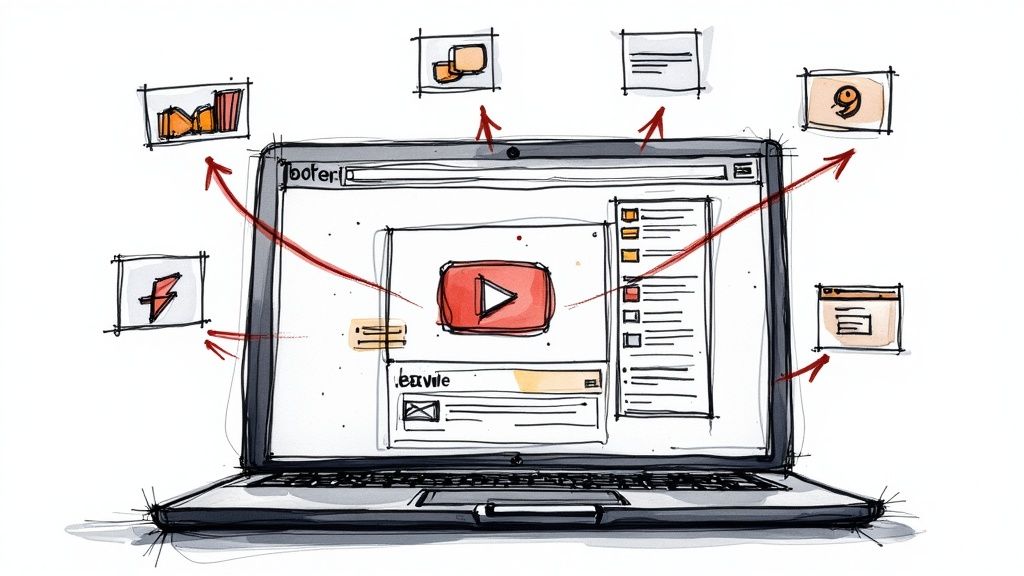
When it comes to creating videos, editing is the moment where everything comes to life. Even though you have all the recorded material, it’s during post-production where you really build the story you want to share. Learning to edit videos goes beyond simply joining clips – it's a creative process that requires both vision and technique to transform raw footage into a captivating piece.
The Art of Editing: Building the Narrative
Editing is like assembling a visual puzzle. By selecting and arranging shots, you create a sequence that captivates the viewer. It’s like building with blocks: each shot by itself may seem simple, but when you combine them with intention, they create something special. The most important thing is to be clear about what you want to convey and what emotions you want to evoke in your audience.
Visual Storytelling: Keeping the Audience's Attention
A good video doesn’t just show pretty images; it tells a story.
Visual storytelling uses images to guide the viewer through the narrative naturally. For example, you can use creative transitions between scenes, vary the editing pace, and combine different shot types. A quick sequence conveys energy, while a longer shot can create suspense or intrigue.
Organizing the Workflow: The Key to Efficiency
Before you start editing, you need to have all your material well-organized. Label each clip, create folders with clear names, and arrange everything logically. This will save you a lot of time later when searching for specific shots. With an organized system, you can focus on the creative part instead of wasting hours looking for lost files.
The Power of Sound: Music and Sound Effects
Music and sound effects are essential to creating the right atmosphere in your video. Good music can convey joy, sadness, or any other emotion you're aiming for. Sound effects make everything feel more real and immersive. But they need to be used carefully. Too many effects can distract from the main message. Think of a horror movie without tense music or a comedy without laughter. The impact would be very different.
Balancing Visual Effects and Content: The Subtlety of Impact
Visual effects can give a professional touch to your video, but it’s important not to overdo it. A well-used effect can highlight an important point or create a smooth transition. However, too many effects can confuse the viewer and make them lose focus on the main message. Remember: content is the most important, and visual effects should support it, not overshadow it. When learning to make videos, less is often more when it comes to effects.
Strategic Multiplatform Distribution
The process of sharing your video with the world requires a well-planned strategy that goes beyond simply uploading it to any platform. To ensure your content reaches the right audience and has the greatest possible impact, you need to understand the specifics of each platform and adapt your “how-to-make-a-video” content accordingly.
Identifying the Ideal Platforms for Your Audience
First, you need to know where your target audience is. Each social media platform has its own personality: YouTube is great for detailed tutorials, while TikTok shines with short , dynamic videos. For example, if you create a full video tutorial on video editing, YouTube would be your main platform, but you could use engaging clips on TikTok to drive traffic to your full content.
Optimizing Your Video for Each Platform
Each platform has its own rules. On Instagram, vertical videos usually grab more attention. For YouTube, it’s crucial to include keywords like “how to make a video” or “video editing tutorial” in the description. Attention-grabbing thumbnails are essential on all platforms. They’re like the cover of your video and determine whether someone will click or keep scrolling.
Building a Community and Fostering Engagement
Uploading the video is just the beginning. To create a loyal audience, you must actively engage: respond to comments, answer questions, and spark conversations about your content. At the end of your videos, invite action: ask viewers to subscribe or share their ideas for future tutorials. This interaction not only strengthens your bond with the audience but also gives you valuable insights for improvement. sino que te da pistas valiosas para mejorar.
Measuring Success and Adjusting the Strategy
Constantly tracking metrics like views, watch time, and shares helps you understand what works and what doesn’t. Look at the trends on each platform and adjust your approach based on the results.Distribution is a continuous learning process. Use the data to refine your techniques and gradually improve the quality of your content.
Examples of Successful Strategies
Many creators have grown significantly by using smart multiplatform strategies. Some focus their efforts on one main platform while using others for support. For example, a tutorial creator might post short clips on TikTok and Instagram, driving viewers to their full videos on YouTube. This strategy leverages the strengths of each social network to build a solid online presence.
Innovation and Trends Shaping the Future
The world of video creation is undergoing significant changes. To connect effectively with your audience, it’s essential to understand the tools and techniques that truly make an impact. It’s not just about following every new trend, but about identifying those innovations that can significantly improve your creative process.
Augmented and Virtual Reality: A New Dimension
Augmented and virtual reality are opening new doors in video production. These technologies allow the creation of more immersive and personalized content. For example, you can develop tutorials where users interact with virtual elements or promotional videos that transport the viewer into the product itself. Their potential goes beyond being just a passing trend.
Vertical Videos: Adapting to the Mobile World
Video consumption on mobile phones has grown significantly, driving the popularity of the vertical format on platforms like TikTok and Instagram. Although horizontal formats still have their place, creating vertical content is crucial to reach more people, especially younger audiences who mainly consume content on their phones.
Borderless Production: Global Collaboration
Digital tools have eliminated geographical limitations in video production. Now, teams from different countries can collaborate on the same project, enriching the content with diverse perspectives. This way of working makes video production more accessible and collaborative than ever.
AI as a Creative Ally
Artificial intelligence is changing the way we edit and produce videos. AI-powered tools can handle technical tasks like color correction or audio transcription, allowing editors to focus on creative aspects. This makes it easier to experiment with new techniques and improve the quality of the final result.
Short Videos: The Power of Brevity
The success of YouTube Shorts has confirmed the preference for short, dynamic videos. This format is perfect for grabbing attention in an environment full of content. Creating short, engaging videos requires a specific focus on storytelling and editing, making it a key skill to connect with new audiences.
¿Necesitas una plataforma confiable para alojar tus pódcasts? Mumbler te ofrece the necessary tools, desde métricas avanzadas hasta inserción de audio. Visita nuestra página para descubrir cómo hacer crecer tu proyecto.
Want to create your videopodcast and reach a larger audience? Book a free consultation at FLIPO..
About the author
Content Manager at Mumbler.
Podcaster and content creator.
Passionate about communication and a fan of the WordPress community.
I talk about movies and series on Babel Infinito.
I talk about podcasting on Todo por Un Podcast.
